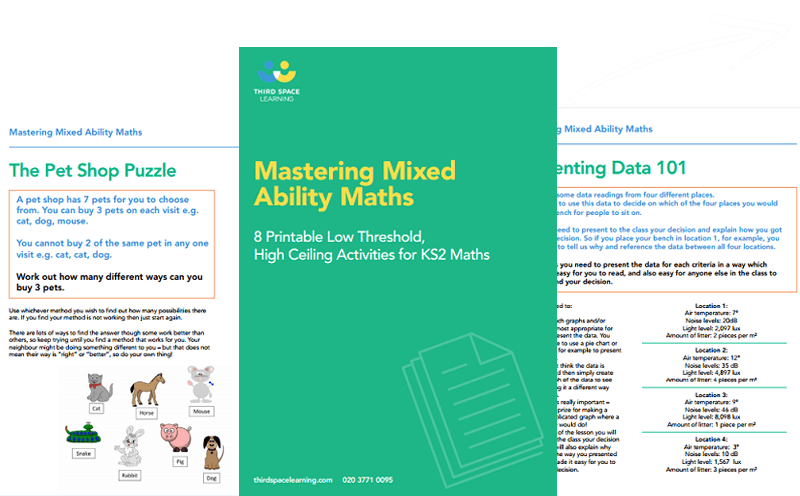Maths Talk for Lower Ability KS2: 5 Proven Strategies
Do you sometimes struggle to engage lower ability or bottom set pupils in Maths talk and expressing their reasoning? You’re not alone if you do. We’ve looked at many different ways to nurture and develop pupils’ spoken and written mathematical vocabulary. These are some of the most effective activities we’ve used in developing the knowledge and skills of pupils who may struggle with Maths.
This is a follow-up post to Talking in Maths lessons [Part 1]: 5 simple activities to build fluency and develop reasoning skills at KS1 and KS2 so it’s worth taking a look at that post first.
1. Model how to use the language
Teachers should first provide a clear model of how to use the new vocabulary in context, ideally reinforced with concrete and pictorial resources. The language should be used at the same time as showing the example to help make the link between the abstract and concrete as clear as possible.
2. Write a script
When new maths language is first introduced it can be useful to provide a talking frame to scaffold discussion. This is effectively a short script of one or two sentences which uses a key word, leaving gaps for the children to fill themselves when applying to different examples. It shows the pupils exactly how and where the vocabulary is used and is particularly useful for less confident learners.
3. Reinforce, reinforce, reinforce
Recap vocabulary at the start of each lesson then refer back to it throughout. Pupils need to use the language themselves, so plan as many opportunities as possible into your lessons for pupils to hear and use the words.
Mastering Mixed Ability Maths Resource
8 engaging printable LTHC activities for upper and lower KS2 that are easy to implement and develop fluency, reasoning & mathematical vocabulary
Download Free Now!4. Display key words to catch attention
Rather than having a static Maths display in your classroom, which can fade into the background and be more like wallpaper, set aside an area as a “Maths Working Wall”. This should be as interactive as possible and reflect the learning taking part that week. The teacher or pupils can add to it throughout the unit of work, pinning up words, drawings, photos and even objects to build a picture of the learning journey. This provides a place for pupils to refer to during lessons when they might be unsure about a particular word or concept. Remember, it doesn’t need to be pretty so it shouldn’t take up too much of your time. This is about providing a resource for the class rather than a beautiful, untouched display.
5. Make time for some 1-to-1 conversation
While partner and group discussions are effective ways of engaging pupils and providing opportunities for mathematical talk, there are limitations. As the class teacher with 30 children to support, you cannot listen to every discussion at once and regardless of best intentions, planning and preparation, the conversations between children will not always be taking place at as high a level as you would like.
“Children cannot be expected to bring to a task a well-developed capacity for reasoned dialogue. This is especially true for the kinds of skills which are important for learning and practising mathematics, such as constructing reasoned arguments and critically examining competing explanations” Strom, D., Kemeny, V., Lehrer, R. and Forman, E. (2001) Visualising the emergent structure of children’s mathematical argument. Cognitive Science, 25, 733–73
As a teacher, talking 1-to-1 with a pupil can be incredibly effective. It is during these opportunities that teachers can most often see pupils have that rewarding, lightbulb moment that we know and enjoy so much as teachers, “Oh, now I get it!”
It doesn’t always have to be you doing the 1-to-1 talk – teaching assistants can be very skilled at drawing pupils out, and parents can be upskilled – but it does help to build some in with each child over a term.
When you don’t find the time to talk
It can be frustrating when we run out of time in our Maths lessons and have no more gaps available in our busy days to fit in important conversations with our pupils. This is where planned and targeted interventions can have a real impact, especially those interventions like our own 1-to-1 that develop pupils’ Maths talk.
I hope you’ve found some of these strategies useful for your own classroom – do let us know what works for you.
DO YOU HAVE STUDENTS WHO NEED MORE SUPPORT IN MATHS?
Every week Third Space Learning’s specialist online maths tutors support thousands of students across hundreds of schools with weekly online 1 to 1 maths lessons designed to plug gaps and boost progress.
Since 2013 these personalised one to one lessons have helped over 150,000 primary and secondary students become more confident, able mathematicians.
Learn how the programmes are aligned to maths mastery teaching or request a personalised quote for your school to speak to us about your school’s needs and how we can help.




